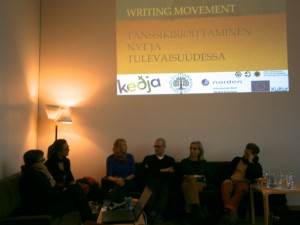Writing Movement – Jyväskylä: “The mission of dance writing is to talk about dance as a part of the society”
The panel discussion series in Finland organised by Liikekieli.com continues. The discussion held September 26th in Jyväskylä City Theatre started by a presentation of Minna Tawast, editor in chief in Teatteri&Tanssi magazine. Other panelists were university lecturer Mariana Siljamäki from the sports education faculty in Jyväskylä University, dance artists Helena Ratinen, Jaakko Nieminen and Jarkko Lehmus and critic Maija-Liisa Westman. The discussion was led by Liikekieli.com’s editor in chief Veera Lamberg.
”Text, like dance, is simultaneously form and content”
Tawast stated in her presentation that multiple voices in dance writing is a very good thing. Teatteri and Tanssi magazines were combined into one publication a year ago which felt appropriate when the boundaries between art forms become more and more blurry. ”There exists no writing, as such, so I talk from my own perspective being journalism”, Tawast stressed. ”Where, who and for whom are the essential questions in writing”, she continued. ”In a magazine the key word is actuality, and other realities are the limited length of the text and the fact that there’s always also someone else who manipulates the text as well. A magazine is devided into columns and it has a rhythm – it is not a book.”
”Text, like dance, is simultaneously form and content. In a text it is almost impossible to be understood in only one way”, she said. ”Describing a dancer’s body is still a taboo even when it has great impacts on the quality and outcome of the movement”, Tawast continued.
Viewpoints on dance and text
Helena Ratinen said that in texts about dance she wants to read about how the dance relates to the world around it.
Mariana Siljamäki completes her doctoral thesis in November 2013 about dance forms originated from different cultures and how they are taught in Finland by pioneering teachers. The doctoral thesis is supervised by professor in dance pedagogy at Theatre Academy Eeva Anttila. Siljamäki commented that there is a lot in common in journalistic and scientific writing.
Jarkko Lehmus told that he had been thinking about his relationship to writing about dance when he was writing a blog while living for six years in Great Britain. ”Communication is a challenging thing. In my own artistic work I have started to research non-verbal ways of directing, for example directing by means of light and sound. My aim is to come into a more straightforward communication with people”, Lehmus stated. In dance writing he would like texts to be relevant also to the dance and cultural field in Europe. He thinks that the mission of dance writing is to talk about dance as a part of the society.
The fact that ”The critic was the third last profession in a ranking list of professions’ popularity published in Suomen Kuvalehti a few years ago, between slaughterer and gravedigger”, was the starting point of the critic Maija-Liisa Westman’s presentation. She writes for Keskisuomalainen newspaper with a deep urge to tell other people, the readers, about valuable things. In the discussion later the issue came up that publishing a review also has its marketing and advertising value, even if one wouldn’t read the content of it.
Dance artist Jaakko Nieminen shared that when he lived in Stockholm 2008-2009 he became aware of the broadness of dance writing. Now the latest two years when he has been in Berlin he has become familiar with the community Books on the Move which promotes the sale and spread of dance books around the world. Nieminen thinks it is essential for the development of the art form that there will be people who are competent also writing about the newest forms of dance.
Artist identity and the effectiveness of a dance performance
The importance that writers would write also about dance forms that don’t happen on stage was an opinion that was shared among the group. It was also mentioned that Dance Info Finland is collecting info about where dance professionals work other than with what is happening on stage. The question is how one should write about these other forms? Minna Tawast said that it is very case specific: ”You have to start from the perspective posited by the artist himself or herself.” The perspective can be to make art, social dance, dance therapeutic work or something else. ”It is a question of how ideas on artist identity and quality are challenged and changing”, Tawast sharpened. The finding and updating of concepts is a part of working in the field which itself is also in an ongoing state of change.
At the end of the discussion people talked about the writer’s challenges of perception when watching a performance and also about how one task of the writer is to bring out the societal value and effectiveness of the work. If the performance for example happens to be very movement-based and abstract, could the writer still try to construe values, worldly relationships and also societal messages based on the movement material itself? It was also pointed out that there are lots of different criteria for effectiveness.
Jenni Sainio
The writer is Writing Movement coordinator together with editor in chief Veera Lamberg in Liikekieli.com.
